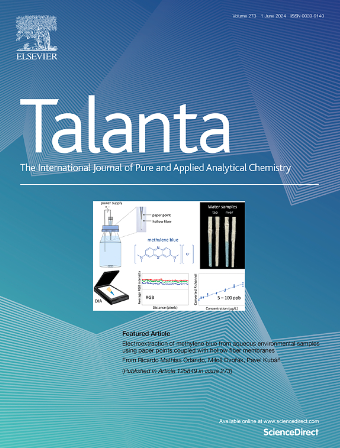一种基于GBLinear和TabNet的挥发性有机化合物混合物分类方法,并从气体传感器(E-Nose)数据中选择信息特征
IF 5.6
1区 化学
Q1 CHEMISTRY, ANALYTICAL
引用次数: 0
摘要
将GBLinear和TabNet算法与基本特征选择技术相结合,创建了一种使用电子鼻系统对精油进行分类的新方法。精油以其复杂的化学成分和在食品、化妆品和制药等行业的广泛应用而闻名,由于挥发性化合物(VOCs)的高度可变性和细微差异,给电子鼻系统带来了一些挑战。这种新颖的方法首次用于电子鼻数据的分析,将高效的机器学习模型与先进的特征选择技术相结合,旨在提高精油分类的准确性和可解释性。该研究强调了将可解释机器学习模型与基于深度学习的架构集成在一起的潜力,以解决复杂气体混合物分析中的挑战。这些方法不仅提高了分类精度,而且可以作为未来分析复杂混合物的有前途的模型。本文章由计算机程序翻译,如有差异,请以英文原文为准。

A novel VOC mixtures classification methods based on GBLinear and TabNet and informative feature selection from gas sensors (E-Nose) data
The GBLinear and TabNet algorithms have been incorporated with essential feature selection techniques to create a new method of classifying essential oils using e-nose systems. Essential oils, known for their complex chemical compositions and a wide variety of applications in industries such as food, cosmetics, and pharmaceuticals, pose some challenges for e-nose systems due to the high variability and subtle differences in volatile compounds (VOCs). This novel approach, used for the first time for the analysis of electronic nose data, integrates efficient machine-learning models with advanced feature selection techniques and aims to increase the accuracy and interpretability of essential oil classification. This study highlights the potential of integrating interpretable machine learning models with deep learning-based architectures to address challenges in the analysis of complex gas mixtures. Not only was the classification accuracy increased by these methods, but these methods could be used in the future as promising models for analyzing complex mixtures.
求助全文
通过发布文献求助,成功后即可免费获取论文全文。
去求助
来源期刊

Talanta
化学-分析化学
CiteScore
12.30
自引率
4.90%
发文量
861
审稿时长
29 days
期刊介绍:
Talanta provides a forum for the publication of original research papers, short communications, and critical reviews in all branches of pure and applied analytical chemistry. Papers are evaluated based on established guidelines, including the fundamental nature of the study, scientific novelty, substantial improvement or advantage over existing technology or methods, and demonstrated analytical applicability. Original research papers on fundamental studies, and on novel sensor and instrumentation developments, are encouraged. Novel or improved applications in areas such as clinical and biological chemistry, environmental analysis, geochemistry, materials science and engineering, and analytical platforms for omics development are welcome.
Analytical performance of methods should be determined, including interference and matrix effects, and methods should be validated by comparison with a standard method, or analysis of a certified reference material. Simple spiking recoveries may not be sufficient. The developed method should especially comprise information on selectivity, sensitivity, detection limits, accuracy, and reliability. However, applying official validation or robustness studies to a routine method or technique does not necessarily constitute novelty. Proper statistical treatment of the data should be provided. Relevant literature should be cited, including related publications by the authors, and authors should discuss how their proposed methodology compares with previously reported methods.
 求助内容:
求助内容: 应助结果提醒方式:
应助结果提醒方式:


